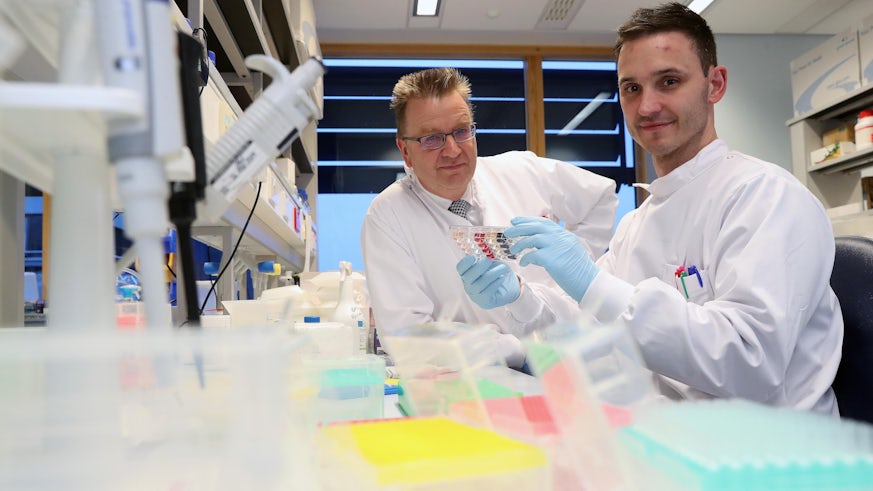Superior T-cell discovered in cancer survivors
24 July 2023

Scientists from Cardiff University have discovered a superior form of killer T-cell in patients who have successfully cleared end stage solid cancer.
Published today in the journal Cell, the researchers discovered that dominant, successful killer T-cells were capable of recognising multiple different cancer-associated targets at the same time.
Until now, scientists believed that individual killer T-cells only saw a single target on cancer cells.
The ‘multipronged’ cells found by the team differ to those previously studied and have superior properties, allowing them to attack cancer in several ways simultaneously.
What did the Cardiff research team do?
The researchers looked at patients with late stage solid cancer who were given TIL (Tumour-infiltrating lymphocyte) therapy at the National Center for Cancer Immune Therapy in Herlev, Denmark (CCIT-DK). TIL therapy takes white blood cells (lymphocytes) from a patient’s tumour, grows them in large numbers in a laboratory, and gives them back to the patient to help the immune system kill the cancer cells. CCIT-DK has pioneered TIL therapy in Europe.
In a phase I/II clinical trial that ran over the last decade, 31 patients were given TIL therapy. All of the TIL cells given to these patients were T-cells.
The team then waited to see which of these patients cleared their cancer and focused on them.
Then, they challenged the blood cells from these patients with stored samples of the patient’s own tumour cells to see which T-cells responded.
They found that the cancer survivors still showed very strong killer T-cell responses to their own cancer over a year after they had cleared it.
The researchers then went on to identify how these killer T-cells were distinguishing cancer cells from normal cells.

Using algorithms, they were able to successfully predict what cancer-specific T-cells recognised based on what the T-cells reacted to and what proteins were known to differ between healthy cells and cancer cells.
They found that the new ‘multipronged’ T-cells were able to recognise multiple changes in proteins inside cancer cells. Overall, they have found these ‘multipronged’ T-cells in several cancer survivors.
Professor Andy Sewell of Cardiff University’s School of Medicine who led the research said: “We wanted to know how some patients with end stage cancer who had been treated with TIL therapy successfully cleared their cancer, so we went hunting for answers.
“By looking at the blood of people whose cancer had totally cleared after TIL therapy, we were able to track down the successful T-cells. We tested them with the person’s own cancer, cancer from other patients as well as other cancer types.
“Our findings really surprised us as nobody knew that individual T-cells could recognise cancer cells via several different cancer-associated proteins simultaneously."
“A multipronged killer T-cell from a cancer survivor was shown to be substantially better at recognising cancer than a normal anticancer killer T-cell.
“In addition, the ability to simultaneously respond to multiple cancer-associated proteins meant that these T-cells could respond to most types of cancer as cancers only needed to express one of the aberrant targets to be identified as dangerous and killed.
“Importantly, we have seen large numbers of multipronged T-cells in the blood of cancer survivors. To date we have not found such multipronged T-cells in people where cancer progresses. Patient numbers are small so far, but it remains possible that multipronged T-cells might be associated with complete remission – or cancer clearance.”
What’s next for research team?
While the new study shows that individual T-cells in cancer survivors can recognise multiple different targets simultaneously and kill a wide range of cancers, further work on bigger cohorts of patients will be required to definitively link multipronged T-cells with cancer clearance.
Successfully predicting what a T-cell recognises is one of the Cancer Grand Challenges and offers the potential to greatly improve future cancer treatment by allowing us to understand what the anticancer T-cells in patients that succeed in clearing their cancer actually recognise.

Professor Sewell said: “This research enhances our knowledge of the role of the immune system in cancer, and while more work needs to be done, it is a positive step in the development of immunotherapies to treat cancer in the future.”
Dr Garry Dolton who is one of the lead authors on the article said: “We have now seen multipronged T-cells in multiple cancer survivors, so examining whether these cells are linked to a good prognosis will be a key next step.
“Beyond that, we can genetically engineer this type of T-cell in the laboratory. So, we hope to investigate whether engineered multipronged T-cells can be used to treat a wide range of cancers in a similar way to how engineered CAR-T cells are now used to treat some types of leukaemia. That research is still some years away yet, but we are encouraged by our findings so far.”
The research Targeting of Multiple Tumor-Associated Antigens by Individual T-cell Receptors During Successful Cancer Immunotherapy is published in the journal Cell and was funded by Wellcome and Danish organizations. It involved researchers at the University of Warwick and Herlev Hospital in Denmark.





